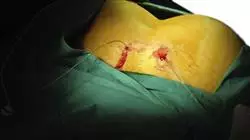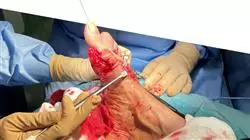University certificate
The world's largest faculty of medicine”
Introduction to the Program
TECH introduces a program specialized in Locoregional Anesthesia so that you can work on updating your clinical practice from wherever you want, thanks to its convenient 100% online format”

The palliative treatment of herniated discs, lumbar, inguinal, femoral, etc.; the reduction of pain in people suffering from diseases associated with the muscle and bone region; or the inhibition of the nerve root of the different areas in which a surgical intervention is to be performed, are the main areas of action of Locoregional Anesthesia. This is a medical specialty whose progress has helped thousands of people to improve their quality of life, through a considerable reduction of the discomforts they suffered in previous centuries. A quite significant example of this technique is the cervical or neuroaxial blocks, in which the vertebral facets are targeted through minimally invasive anesthetic therapies that contribute to a significant reduction of pain.
However, as in General Anesthesia, this type of procedures must be subject to an exhaustive control of the techniques, as well as of the considerations to be taken into account to avoid side effects harmful to health depending on the type of patients (children, elderly, people with various pathologies, pregnant women, etc.). For this reason, TECH Global University has developed a complete program with which, in just 12 months, you will be able to get up to date on all clinical and therapeutic developments in Locoregional Anesthesia. This Professional master’s degree will cover from the most innovative therapies to non-invasive clinical and surgical strategies for the different body regions. Furthermore, it will focus on pain-inhibiting palliative care in various types of patients, taking into account their physiological characteristics. All of this is based on the use of the latest drugs that have been tested with guarantees and are applicable at an international clinical level.
In order to achieve this, the professional will have 1,500 hours of theoretical and practical material, designed exclusively for this degree by a teaching team specialized in Anesthesiology, Resuscitation and Pain Therapy. Moreover, its convenient 100% online format will allow you to update your practice from wherever and whenever you want, in a way that is compatible with your professional activity. Therefore, it is a unique opportunity to work on perfecting your medical skills with the endorsement of the largest medical faculty in the world.
You will work on the latest developments in the application of anesthesia in the upper extremities, lower extremities, head and neck, delving into the most innovative clinical strategies for each case”
This Professional master’s degree in Locoregional Anesthesia contains the most complete and up-to-date scientific program on the market. The most important features include:
- Practical cases presented by experts in Locoregional Anesthesiology
- The graphic, schematic, and practical contents with which they are created, provide scientific and practical information on the disciplines that are essential for professional practice
- Practical exercises where self-assessment can be used to improve learning
- Its special emphasis on innovative methodologies
- Theoretical lessons, questions to the expert, debate forums on controversial topics, and individual reflection assignments
- Content that is accessible from any fixed or portable device with an Internet connection
Would you like to get up-to-date on what's new in Major Outpatient Surgery for anesthesiologists? If the answer is yes, this program is perfect for you"
The program’s teaching staff includes professionals from the sector who contribute their work experience to this educational program, as well as renowned specialists from leading societies and prestigious universities.
Its multimedia content, developed with the latest educational technology, will allow the professional a situated and contextual learning, that is, a simulated environment that will provide an immersive education programmed to prepare in real situations.
This program is designed around Problem-Based Learning, whereby the professional must try to solve the different professional practice situations that arise during the academic year For this purpose, the student will be assisted by an innovative interactive video system created by renowned and experienced experts.
Due to its convenient format and the hundreds of hours of additional material included in the program, you will be able to delve into the latest advances in critical treatments through Regional Anesthesia"

A program that will give you the keys to provide pain relief to your patients, through the most effective and innovative clinical guidelines of current Anesthesiology"
Why study at TECH?
TECH is the world’s largest online university. With an impressive catalog of more than 14,000 university programs available in 11 languages, it is positioned as a leader in employability, with a 99% job placement rate. In addition, it relies on an enormous faculty of more than 6,000 professors of the highest international renown.

Study at the world's largest online university and guarantee your professional success. The future starts at TECH”
The world’s best online university according to FORBES
The prestigious Forbes magazine, specialized in business and finance, has highlighted TECH as “the world's best online university” This is what they have recently stated in an article in their digital edition in which they echo the success story of this institution, “thanks to the academic offer it provides, the selection of its teaching staff, and an innovative learning method aimed at educating the professionals of the future”
A revolutionary study method, a cutting-edge faculty and a practical focus: the key to TECH's success.
The most complete study plans on the university scene
TECH offers the most complete study plans on the university scene, with syllabuses that cover fundamental concepts and, at the same time, the main scientific advances in their specific scientific areas. In addition, these programs are continuously being updated to guarantee students the academic vanguard and the most in-demand professional skills. In this way, the university's qualifications provide its graduates with a significant advantage to propel their careers to success.
TECH offers the most comprehensive and intensive study plans on the current university scene.
A world-class teaching staff
TECH's teaching staff is made up of more than 6,000 professors with the highest international recognition. Professors, researchers and top executives of multinational companies, including Isaiah Covington, performance coach of the Boston Celtics; Magda Romanska, principal investigator at Harvard MetaLAB; Ignacio Wistumba, chairman of the department of translational molecular pathology at MD Anderson Cancer Center; and D.W. Pine, creative director of TIME magazine, among others.
Internationally renowned experts, specialized in different branches of Health, Technology, Communication and Business, form part of the TECH faculty.
A unique learning method
TECH is the first university to use Relearning in all its programs. It is the best online learning methodology, accredited with international teaching quality certifications, provided by prestigious educational agencies. In addition, this disruptive educational model is complemented with the “Case Method”, thereby setting up a unique online teaching strategy. Innovative teaching resources are also implemented, including detailed videos, infographics and interactive summaries.
TECH combines Relearning and the Case Method in all its university programs to guarantee excellent theoretical and practical learning, studying whenever and wherever you want.
The world's largest online university
TECH is the world’s largest online university. We are the largest educational institution, with the best and widest online educational catalog, one hundred percent online and covering the vast majority of areas of knowledge. We offer a large selection of our own degrees and accredited online undergraduate and postgraduate degrees. In total, more than 14,000 university degrees, in eleven different languages, make us the largest educational largest in the world.
TECH has the world's most extensive catalog of academic and official programs, available in more than 11 languages.
Google Premier Partner
The American technology giant has awarded TECH the Google Google Premier Partner badge. This award, which is only available to 3% of the world's companies, highlights the efficient, flexible and tailored experience that this university provides to students. The recognition as a Google Premier Partner not only accredits the maximum rigor, performance and investment in TECH's digital infrastructures, but also places this university as one of the world's leading technology companies.
Google has positioned TECH in the top 3% of the world's most important technology companies by awarding it its Google Premier Partner badge.
The official online university of the NBA
TECH is the official online university of the NBA. Thanks to our agreement with the biggest league in basketball, we offer our students exclusive university programs, as well as a wide variety of educational resources focused on the business of the league and other areas of the sports industry. Each program is made up of a uniquely designed syllabus and features exceptional guest hosts: professionals with a distinguished sports background who will offer their expertise on the most relevant topics.
TECH has been selected by the NBA, the world's top basketball league, as its official online university.
The top-rated university by its students
Students have positioned TECH as the world's top-rated university on the main review websites, with a highest rating of 4.9 out of 5, obtained from more than 1,000 reviews. These results consolidate TECH as the benchmark university institution at an international level, reflecting the excellence and positive impact of its educational model.” reflecting the excellence and positive impact of its educational model.”
TECH is the world’s top-rated university by its students.
Leaders in employability
TECH has managed to become the leading university in employability. 99% of its students obtain jobs in the academic field they have studied, within one year of completing any of the university's programs. A similar number achieve immediate career enhancement. All this thanks to a study methodology that bases its effectiveness on the acquisition of practical skills, which are absolutely necessary for professional development.
99% of TECH graduates find a job within a year of completing their studies.
Professional Master's Degree in Locoregional Anesthesia
The use of regional and local anesthesia has been extended to different medical fields, seeking to offer patients treatments and surgical interventions that significantly reduce and control pain. However, its application requires a solid base of knowledge and technical skills in the field, since its improper handling could represent a risk to the health of people. At TECH Global University we developed the Professional Master's Degree in Locoregional Anesthesia, a program designed with the purpose of updating and complementing the studies of professionals in anesthesiology so that they can safely perform the daily practice of their functions in this clinical area. In this way, you will become an expert in the use of different anesthesiological drugs taking into account their side effects, the type of patient and the area of application. Take this postgraduate degree and advance your career goals.
Become a specialist at the largest Faculty of Medicine
With our Professional Master's Degree, delivered in a 100% online format, you will have access to the latest advances available in anesthesiological intervention, as well as the clinical strategies recommended for each case. Through theoretical lessons, discussion forums and the study of real clinical cases, you will learn the basics of neuroaxial anesthesia and locoregional blocks; you will become familiar with the anatomy, physiology and pharmacology involved in the use of local anesthetics; you will analyze the indications, contraindications, technical aspects and complications derived from anesthetic assistance; and you will identify the specific situations to be taken into account in this discipline, such as symptoms, causes and risk factors of intoxication, for its correct approach and treatment. At TECH Global University you will achieve a higher level of knowledge and boost your career growth.







